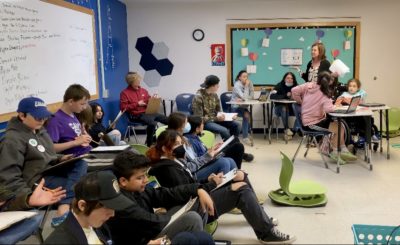
After a year-long controversy and a legal battle, the State Board of Education approved Thursday a list of four K-3 reading diagnostic tools that districts can choose from this year.
The Department of Public Instruction (DPI) presented a list of five tools to the Board last week, and the Board ultimately approved four of these tools today:
- NWEA
- STAR Reading
- Istation
- i-Ready (pending final results about EVAAS compatibility)
The Board left the door open for additional vendors to come forward if they can provide the necessary EVAAS, or Education Value-Added Assessment System, and Lexile level study data, but even if they do get approved, it may not be in time for districts to sign a contract for this upcoming school year. Districts will be able to contract with any of the approved diagnostic tools for one year until the Board approves a statewide tool.
The Board also addressed how to spend its statewide CARES Act funding reserve, new K-12 social studies standards, and an Innovative School District report this week. Here’s what you need to know.
CARES Act funding
The Board approved its own plan to spend approximately $39 million in federal CARES Act funding in a split vote. Facing a July 11 deadline to submit a plan to the U.S. Department of Education, the Board voted 7-3 to approve a budget that prioritizes exceptional children (EC) instructional support and overall digital curricula support for the 2020-2021 school year.
Here’s the full approved plan:
As part of the CARES Act, North Carolina public schools received $389 million. The bulk of that — 90% — was passed along to districts, but the state was authorized to hold back a 10% reserve that it could use in its efforts to battle COVID-19 impacts on education statewide.
The state Department of Public Instruction presented its own plan to the Board that had some significant differences, mainly in how it allotted funds to child care services and prepackaged instruction materials. While the Board allotted $10.8 million for digital curricula, DPI wanted $8.8 million with an additional $7 million for spring 2020 and beyond.
The Board and DPI largely agreed that this will be important for teachers so they can spend more time forming personal connections with students during remote learning.
Here’s the full proposal from DPI:
Another big difference was that DPI proposed spending $15 million — about a third of the total budget — on family and child care services. State Superintendent Mark Johnson said this could help parents, especially those that are teachers, get back to work if districts continue remote learning. But Board member JB Buxton said the Board needs more clarity on if these needs are already met through federal funding and what exactly the $15 million amount could provide.
The Board’s plan allocates $4.4 million for child care services.
Board Vice Chair Alan Duncan said the state’s needs are too large for the approximately $39 million it’s receiving, and the Board has to balance priorities with its other obligations, like Leandro and equity initiatives. He said this is a big reason why the Board’s plan also includes $10 million to support services and instructional support for children with learning differences.
Johnson said he has serious concerns about the Board’s plan.
“I think this second document was done without DPI input, and this is what happens when the State Board and DPI aren’t working together,” he said.
Social studies standards
After delaying the vote for another month at its June meeting, the Board again voted to delay adoption of new K-12 social studies standards, this time until early spring 2021.
After reviewing a new introductory statement and more detailed information about the installation strategy, some Board members still felt there wasn’t enough support for teachers to implement the new curriculum on top of challenges already caused by remote learning. The original plan presented to the Board called for this upcoming school year to be an installation year where DPI would develop materials, not a classroom implementation year.
“I’ve not had a single educator or parent advocate who has called for implementation this year, I haven’t had a single one,” said Matt Bristow-Smith, Board principal advisor. He said students want a more robust and profound history education, particularly given the “contemporary civil rights activism” happening now, but he said he believes the Board needs more time to make sure the standards will be implemented properly.
The discussion was also dominated by questions about when the standards become so specific that they get too close to being curricula topics. You can read them here.
Buxton said these standards revisions came before the Board at a “particularly important time.” Earlier in the meeting, the Board heard from students and a teacher at Middle Creek High School who had experience taking a “hard history” class that taught them about social justice and racism in North Carolina. The students questioned the way — and the extent to which — these subjects are taught in the state and called on the Board to consider these priorities.
KaLa Keaton, one of these students, said she didn’t learn about the white supremacist riots in Wilmington in 1898, the loophole in the 13th amendment, or NASA scientist Katherine Johnson at her North Carolina public school.
“If these weren’t deemed important enough, what exactly have I learned over 13 years?” she asked the Board.
Rather than approving the standards, the Board instead approved a revision to graduation requirements for the incoming class and beyond until new standards are finalized.
Innovative School District
The Board heard the second-year report about the Innovative School District (ISD) at Southside-Ashpole Elementary in Robeson County, but that came with limitations. Trip Stallings previously carried out an evaluation of the ISD as Director of Policy Research at the Friday Institute, though he is no longer in that position. He presented the report to the Board and noted that the data was still only based on one school after another year of the program, and disruptions due to COVID-19 limited the amount of data that could be collected.
“The evaluation team was able to complete all planned visits to the school and also administer all planned surveys; however, since no state tests were administered for 2019-20, there is no new information in this report about quantitative measures of academic achievement for Year 2,” the report says.
Although Stallings said population changes at the school made it difficult to assess changes, the school culture is reportedly more positive as administrators get used to their roles and parents become more comfortable interacting with them. However, a noted challenge was retaining high-quality teachers due to the significant time commitment of working at the school and teacher compensation.
Even based on the lack of data he was able to present, Stallings presented recommendations to the Board. These included addressing the disconnect between curriculum freedom and state standards to improve evaluation, and measuring progress between legacy and new students differently.
But he said more needs to be done to improve the ISD initiative as a whole. According to the report, this includes considering what an ISD has to offer as opposed to another option such as charter schools. He said the state has almost no modern experience running a disparate geographical school district, so the ISD needs to formulate a plan for remote management, especially if the initiative is supposed to expand to other schools.
You can read the full report here:
Here’s what else you need to know:
- The Board approved a definition for high-quality reading instruction for birth through third grade: “High quality reading instruction is grounded in the current science of reading regarding the acquisition of language (syntax, semantics, morphology, and pragmatics), phonological and phonemic awareness, accurate and efficient word identification and spelling, word knowledge, and comprehension. High quality reading instruction includes explicit and systematic phonics instruction, allowing all students to master letter-sound relations, and it is guided by state-adopted standards and informed by data so that instruction can be differentiated to meet the needs of individual students. Ultimately, the purpose of high quality reading instruction is to empower all children to become deep readers who have the foundational skills and word and world knowledge to read and understand increasingly complex text.”
- Johnson called on the Board to have their August meeting in person if they expect teachers and students to return to school. He said DPI staff will resume in-person work as well.
- The Board reviewed an equity resolution that would urge districts to rename buildings with racist names, work to ensure that students “see themselves in their education,” and “desegregate schools wherever possible.” Some Board members had questions about using terms like “desegregate” and “punitive disciplinary practices.” Here’s the full resolution:
Correction: A previous edition of this article incorrectly stated that Katherine Johnson was a NASA astronaut. She was a NASA scientist.
Recommended reading



